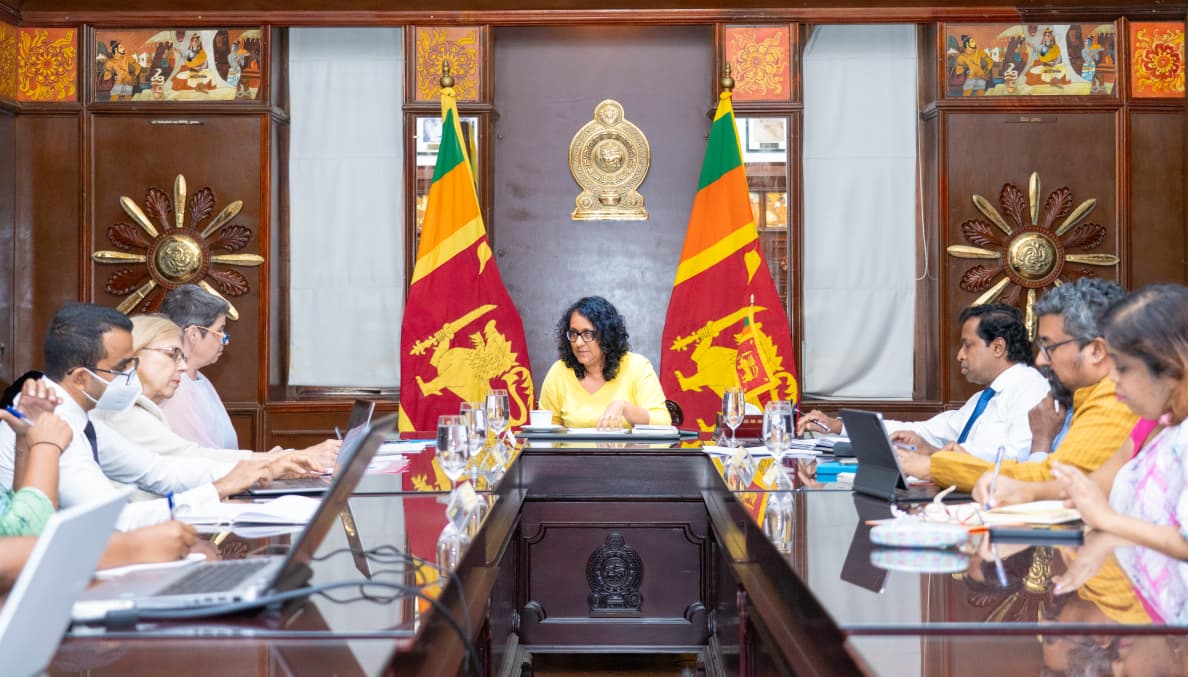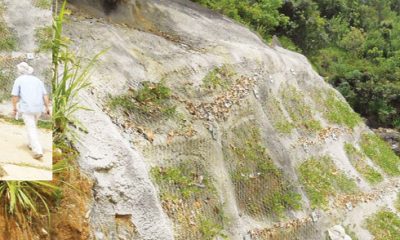News
Retracing historical and cultural links between Tamil Nadu and Sri Lanka

By T. Ramakrishnan
The recently consecrated Thiruketheeswaram temple in Mannar in Sri Lanka’s Northern Province has come to symbolise close ties between Tamil Nadu and the island nation, thanks to the involvement of the Government College of Architecture and Sculpture, Mamallapuram, in the temple’s restoration.
Regarded as one of the five important abodes of Lord Shiva in Sri Lanka, the temple, said to have been worshipped by Saivite saint Thirugnanasambandar, was damaged during the protracted civil war that ended in May 2009. It had a fresh lease of life following the Indian government’s decision to fund the renovation project and lend its technical expertise. The ‘mahamandapam’ was renovated with the support of the Mamallapuram college and materials, including granites, were procured from Tamil Nadu. While the Indian government provided a grant of LKR 320 million for the restoration, which eventually cost LKR 900 million, the Archaeological Survey of India supervised its execution.
Beyond Thirukeetheswaram, the relationship between the two territories can be traced to the proto-historic times. Marks, similar to graffiti inscribed potsherds discovered during early excavations at Adichanallur, Korkai and many other sites of the Early Historic period, were recovered from places such as Tissamaharama, Kantarodai, Manthai and Ridiyagama in Sri Lanka, according to a 2019 publication of the Tamil Nadu Department of Archaeology on Keeladi. Historians also refer to continuous trade links between the two regions, citing the discoveries in Tamil Nadu of Sinhala Prakrit inscriptions on pottery.
In fact, veteran numismatist, art historian and archaeologist of Sri Lanka Osmund Bopearachchi has even recorded in a 2008 paper on ancient Sri Lanka and Tamil Nadu that Sinhalese traders were present in Tamil Nadu in the same period when Tamil traders were active at Anuradhapura and Tissamaharama in Sri Lanka.
He has also stated that the epigraphic and literary evidence for “the active role played by Tamil merchants in the early phase of Sri Lanka’s history is numerous”. In a conversation with this newspaper in 2017, Dr. Bopearachchi, former Adjunct Professor of Central and South Asian Art, Archaeology, and Numismatics, University of California, Berkeley, said, “The earliest coins found in Sri Lanka were Pandya and Chera coins.”
In K.A. Nilakanta Sastri’s seminal work, A History of South India, one can find numerous accounts of battles between rulers of southern India and Sri Lanka. A significant account of them pertains to how Rajendra Chola-I (1012-44 CE) completed the conquest of Sri Lanka begun by his father Rajaraja Chola (985-1016 CE) and Mahinda V’s son, Kassapa, became the centre of Sinhalese resistance to the Tamil power. Sri Lanka’s prominent historian K.M. de Silva, in his landmark work A History of Sri Lanka, points out that Nayakkars, who belonged to the Vaduga caste, “a Telugu-speaking group originally hailing from Madurai,” established marriage ties with the Kandyan royal family during the 17th century. He adds that the accession of the Nayakkar dynasty to the Kandyan throne in 1739 CE was “accommodated with the minimum of disturbance”.
On the side of culture and religion, Kataragama in the deep south, once regarded by people in Tamil Nadu as one of the six abodes of Lord Muruga, has shrines for Muruga, Shiva and Deivanai Amman, making any visitor from Tamil Nadu feel at home. Aimed at attracting a larger number of tourists from Tamil Nadu, the Sri Lankan authorities are planning to launch a Muruga trail, apart from the old Ramayana trail. Rajaraja Chola had got people of Sri Lanka involved in the construction of the Brihadeeswara temple in Thanjavur, says M. Rajendran, former Vice-Chancellor of Tamil University.
G.P.V. Somaratna, former Head of Department of History and Political Science, University of Colombo, in his paper ‘Tamil Buddhism in Sri Lanka’, states that the presence of Buddhism in ancient Tamil Nadu had a “great impact” on Buddhist activities in Sri Lanka and the northern part of the island in particular.
Since the classical period, there have been significant contributions from literary personalities belonging to Sri Lanka’s Tamils to Tamil literature. Tamil scholar of yesteryear Mu. Varadarajan, in his work on the history of Tamil literature ( Tamil Illakkiya Varalaru), records that Eezhathu Poothanthevanar, a poet from Sri Lanka, had composed seven verses of the Sangam anthology.
Ayathurai Santhan, an award-winning Sri Lankan Tamil writer, notes that one of the Tamil classics, Manimekalai, refers to an islet, Manipallavam, which has been identified with the present Nainativu of Sri Lanka. Dr. Rajendran observes that the Pathni cult, the worship of Kannaki, had spread to Sri Lanka from Tamil Nadu.
Prominent scholars Arumuga Navalar (1822-1889) and C.V. Damodaram Pillai (1832-1901) had strong connections with Chennai. Tiruppur Krishnan, editor of Amudhasurabhi, refers to Vipulananda Adigal (1892-1947), who was known not only for his work in the expansion of activities of Ramakrishna Mission in Sri Lanka but also for his contribution to Tamil literature. He recalls how veteran writer-editors such as Ki. Va. Jagannathan (1906-88) and Naa. Parthasarathy (1932-87) made it a point to visit Sri Lanka regularly for mobilising subscriptions for their journals, Kalaimagal and Deepam. Mr. Santhan is of the view that K. Kailasapathy, Karthigesu Sivathamby, Dominic Jeeva and Se. Ganesalingan were among those who left behind a huge impact on the Tamil literary field.
In recent years, the social relationship between people of Sri Lanka and those of India in general, Tamil Nadu in particular, has only grown due to a variety of reasons. Be it the 1983 anti-Tamil pogrom or the present spell of economic crisis, sections of Sri Lankan society have found in Tamil Nadu a safe haven. But, given the historical, cultural and sociological factors, there are deeper reasons for the peoples of the two lands to be closer than what they have been.
(The Hindu)
Latest News
Pregnant Mothers to receive Rs 5000 Nutrition Allowance in December

Based on the prevailing disaster situation and the upcoming festive season, arrangements have been made to provide a nutrition allowance worth Rs. 5,000 to pregnant mothers.
This allowance, which will be provided only once, will be given to pregnant mothers who were registered at maternal clinics on or before 30 November 2025.
The distribution will take place through the Divisional Secretariat offices from 16 December, as a program of the National Secretariat for Early Childhood Development, which is affiliated with the Ministry of Women and Child Affairs.
Latest News
640 deaths, 211 missing as at 6:00AM today (13)

The Situation Report released by the Disaster Management Centre (DMC) at 6:00 AM today (13th December 2025) confirms that 640 persons have died and another 211 persons are missing due to flooding and landslides that took place in Sri Lanka within the past two weeks.

News
New Digitalization Policy draft reviewed

A meeting between representatives of UNICEF and Prime Minister Dr. Harini Amarasuriya was held on the 10th of December at the Prime Minister’s Office.
During the discussion, an initial review of the new digitalization policy draft was conducted, and it was emphasized that the new digital policy must be formulated to align with the ongoing education reforms.
The Prime Minister highlighted that the digital policy should be developed in a way that supports all five core pillars of the current education reforms, including curriculum reform, infrastructure development, and administrative restructuring.
It was further noted that the current draft is primarily focused on curriculum-related matters, and the digital policy should be structured to influence the overall education reform process.
Extensive discussions were also held on the importance of digital literacy, NEMIS, the provision of digital infrastructure, and minimizing the existing digital divide.
Attention was also drawn to the gaps in the current teacher training mechanisms , and the Prime Minister stressed the need to reduce paper usage.
The meeting was attended by the UNICEF representatives Dr. Emma Brigham and Deborah Wyburn, Secretary to the Prime Minister Pradeep Saputhanthri, Additional Secretary A.B.M. Ashraff, and several other officials.
[Prime Minister’s Media Division]
-

 Features3 days ago
Features3 days agoFinally, Mahinda Yapa sets the record straight
-

 News5 days ago
News5 days agoOver 35,000 drug offenders nabbed in 36 days
-

 News4 days ago
News4 days agoCyclone Ditwah leaves Sri Lanka’s biodiversity in ruins: Top scientist warns of unseen ecological disaster
-

 Features6 days ago
Features6 days agoThe Catastrophic Impact of Tropical Cyclone Ditwah on Sri Lanka:
-

 News5 days ago
News5 days agoRising water level in Malwathu Oya triggers alert in Thanthirimale
-

 Features3 days ago
Features3 days agoHandunnetti and Colonial Shackles of English in Sri Lanka
-

 Business2 days ago
Business2 days agoCabinet approves establishment of two 50 MW wind power stations in Mullikulum, Mannar region
-

 Business5 days ago
Business5 days agoSri Lanka betting its tourism future on cold, hard numbers













